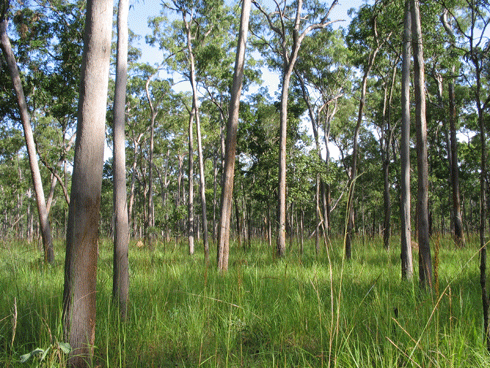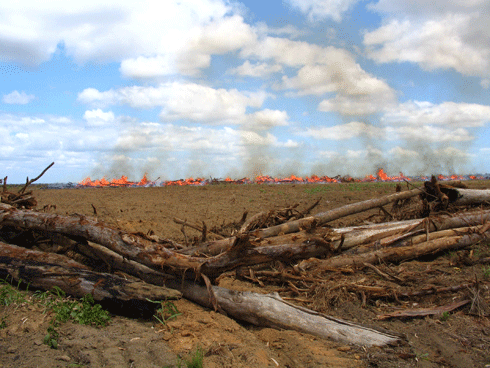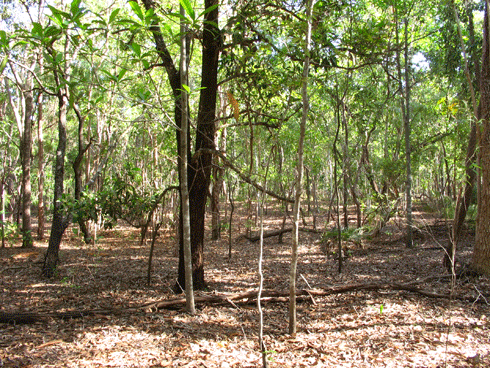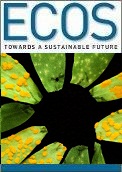
|
Published: 12 December 2011
Post-mining rehabilitation doesn’t restore habitat equivalent to that removed by mining
A research case study from the monsoonal tropics of northern Australia indicates that assumptions about post-mining rehabilitation success need to be reviewed.

|
|
Pre-mining forest habitat (2006) at the case study bauxite mine site, Weipa, Cape York Peninsula. Credit:
Sue Gould
|
It is commonly assumed that we are able to ‘restore’ habitat and that we are able to accelerate natural processes of ecosystem change. Our theoretical models of how ecosystems change have largely been derived from observations of how natural systems respond to natural disturbance events. These models only hold true, though, to the extent that the biological legacy of the original vegetation is retained both at the site of disturbance, and in the surrounding landscape.
Research in synthetic ecosystems1 is revealing that some key assumptions about how ecosystems change are incorrect. A case in point is rehabilitation following bauxite mining at Weipa on Cape York Peninsula in far north Queensland, which was the subject of my research. Here, the bauxite ore body occurs as a shallow deposit over large parts of north-western Cape York Peninsula. Darwin Stringybark open forest grows closely associated with the Weipa bauxite plateau which provides a deep, well-drained matrix.
The ongoing bauxite mining process involves completely clearing the vegetation and stripping approximately 50 cm of soil for use in rehabilitation. Mining on the Weipa bauxite plateau lowers the landscape on average by 2–3 metres. After the ore body is removed, the stripped soil is re-spread over the mine floor. Rehabilitation sites are ripped, ploughed, fertilised and direct seeded with a mix of species.

|
|
Preparing for mining (2006) at the case study bauxite mine site, Weipa, Cape York Peninsula. Credit:
Sue Gould
|
The plant species mix used in the rehabilitation sites studies was based on a facilitation model of vegetation succession. This assumes that initial ‘pioneer’ species will improve site conditions for later species, and that they will then senesce and be replaced by ‘late successional’ species. Large-seeded, fast-growing species that germinate reliably from seed, for example acacias, are used in the expectation that they will re-build nitrogen stocks in the soil then die and be replaced by more long-lived, slow-growing eucalyptus species.
However, my comparison of vegetation and birds between pre-mining native forest and post-mining rehabilitation at Weipa shows that expectations of how rehabilitation would develop over time have not been met. Rehabilitation successfully establishes vegetation cover but, in sites over 20 years old, it remains dominated by acacias. The desired eucalyptus species that provide key habitat resources for local native forest birds are only established at very low densities. Because of the differences in vegetation, the bird community in rehabilitation also differs significantly from the bird community in pre-mining native forest.
The habitat requirements of many bird species are much more specific than people realise. Whenever habitat changes, the distributions of some bird species expand while others contract. Often, it is the mobile, generalist species that are the winners, while more sedentary species or habitat specialists decline. My findings show that unless rehabilitation is able to restore habitats very similar to the pre-mining native forest, it will not provide suitable habitat for approximately a third of the native forest bird species.

|
|
21-year-old post-mining revegetation at Weipa, showing significant difference in the vegetation community. Credit:
Sue Gould
|
Rehabilitation at Weipa has achieved limited success. It has established vegetation cover and it does provide habitat for birds. However, it has resulted in habitat conversion rather than habitat restoration. Without costly management intervention, the differences in vegetation composition are likely to persist. Therefore, we can say that mining on the Weipa bauxite plateau causes long-term, if not, permanent, loss of the original ecosystem with long-term consequences for the forest-dependent birds whose habitat is cleared for mining.
My research highlights the need to question the assumptions that we can restore habitat in highly modified landscapes, such as post-mining landscapes, and that restoration can be fast-tracked.
Sue Gould is a visiting fellow at the Fenner School of Environment and Society, Australian National University, Canberra and is author of the recently published research article, ‘Does post-mining rehabilitation restore habitat equivalent to that removed by mining? A case study from the monsoonal tropics of northern Australia, in Wildlife Research 38(6) 482-490, 11 November 2011.
1 Synthetic ecosystems are those made up of new combinations of species as a result of species selection by humans, invasion by exotic species or alteration of environmental conditions or a combination of these effects.



